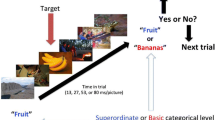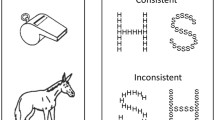Studies using a direct masking model addressed the influences of the time characteristics of masker presentation on the performance of basic and superordinate categorization (BC and SC) of images of objects in healthy young subjects. Maskers could be congruent, incongruent, or semantically neutral with respect to the target image. The first series analyzed the effect of asynchrony in the onset of stimulus presentation (stimulus onset asynchrony, SOA, i.e., the time interval between the onset of masker and stimulus presentations), which varied from 100 to 350 msec in 50-msec steps with a constant masker duration of 100 msec. The second series analyzed the effect of masker duration, which increased from 100 to 250 msec in steps of 50 msec with a constant SOA of 250 msec. SC was found to occur faster than BC. This is presumptively due to the participation of the low-frequency component of the stimulus description in SC, this component being transmitted rapidly via the magnocellular visual pathway. BC was more sensitive than SC to the temporal characteristics of the masker and its categorical affiliation. Furthermore, changes in SOA had a greater effect than masker duration on reaction time. If we accept the suggestion that changes in SOA influence the early perceptual stage of stimulus processing, then its sensitivity to unimportant information is apparent as a stronger dependence of BC than SC on SOA.
Similar content being viewed by others
References
Ashtiani, M. N., Kheradpisheh, S. R., Masquelier, T., and Ganjtabesh, M., “Object categorization in finer levels relies more on higher spatial frequencies and takes longer,” Front. Psychol., 8, 1261 (2017).
Carlson, T. A., Ritchie, B., Kriegeskorte, N., et al., “Reaction time for object categorization is predicted by representational distance,” J. Cogn. Neurosci., 26, No. 10, 132–142 (2014).
Codispoti, M., Ferrari, V., De Cesarei, A., and Cardinale, R., “Implicit and explicit categorization of natural scenes,” Prog. Brain Res., 156, 53–65 (2006).
Cohen, M. A., Alvarez, G. A., Nakayama, K., and Konkle, T., “Visual search for object categories is predicted by the representational architecture of high-level visual cortex,” J. Neurophysiol., 117, 388–402 (2017).
Cohen, M. A., Konkle, T., Rhee, J. Y., et al., “Processing multiple visual objects is limited by overlap in neural channels,” Proc. Natl. Acad. Sci. USA, 111, No. 24, 8955–8960 (2014).
Connolly, A. C., Guntupalli, J. S., Gors, J., et al., “The representation of biological classes in the human brain,” J. Neurosci., 32, No. 8, 2608–2618 (2012).
Contini, E. W., Goddard, E., and Wardle, S. G., “Reaction times predict dynamic brain representations measured with MEG for only some object categorization tasks,” Neuropsychology, 151, 107687 (2021).
Davis, T. and Poldrack, R. A., “Quantifying the internal structure of categories using a neural typicality measure,” Cereb. Cortex, 24, 1720–1737 (2014).
Eddy, M. D. and Holcomb, P. J., “The temporal dynamics of masked repetition picture priming effects: manipulations of stimulus-onset asynchrony (SOA) and prime duration,” Brain Res., 1340, 24–39 (2010).
Fabre-Thorpe, M., “The characteristics and limits of rapid visual categorization,” Front. Psychol., 2, 243 (2011).
Farzmahdi, A., Fallah, F., Rajimehr, R., and Ebrahimpour, R., “Taskdependent neural representations of visual object categories,” Eur. J. Neurosci., 54, 6445–6462 (2021).
Gerasimenko, N. Yu., Kushnir, A. B., and Mikhailova, E. S., “Masking effects of irrelevant visual information in conditions of basic and superordinate categorization of complex images,” Fiziol. Cheloveka, 45, No. 1, 5–18 (2019).
Grill-Spector, K. and Weiner, K. S., “The functional architecture of the ventral temporal cortex and its role in categorization,” Nat. Rev. Neurosci., 15, No. 8, 536–548 (2014).
Hantsch, A., Jescheniak, J. D., and Mädebach, A., “Naming and categorizing objects: Task differences modulate the polarity of semantic effects in the picture-word interference paradigm,” Mem. Cognit., 40, 760–768 (2012).
Huth, A. G., Nishimoto, S., Vu, A. T., and Gallant, J., “A continuous semantic space describes the representation of thousands of object and action categories across the human brain,” Neuron, 76, 1210–1224 (2012).
Jiang, Z., Qu, Y., **ao, Y., et al., “Comparison of affective and semantic priming in different SOA,” Cogn. Process., 17, 357–375 (2016).
Kalinin, S. A., Gerasimenko, N. Yu., Slavutskaya, A. V., and Mikhailova, E. S., “Behavioral and electrographic characteristics of recognition of complex images under conditions of direct masking. Effect of categorical proximity of target and masking stimuli,” Fiziol. Cheloveka, 40, No. 4, 5–17 (2014).
Ko, P. C., Duda, B., Husseya, E. P., et al., “The temporal dynamics of visual object priming,” Brain Cogn., 91, 11–20 (2014).
Koivisto, M. and Rientamo, E., “Unconscious vision spots the animal but not the dog: Masked priming of natural scenes,” Conscious. Cogn., 41, 10–23 (2016).
Kutas, M. and Federmeier, K. D., “Thirty years and counting: finding meaning in the N400 component of the event-related brain potential (ERP),” Annu. Rev. Psychol., 62, No. 1, 621–647 (2011).
Lakoff, G., Women, Fire and Dangerous Things: What Categories Reveal about the Mind [Russian translation], Languages of Slavic Cultures Press, Moscow (2004).
Long, B., Yu, C. P., and Konkle, T., “Mid-level visual features underlie the high-level categorical organization of the ventral stream,” Proc. Natl. Acad. Sci. USA, 115, No. 38, E9015–E9024 (2018).
Mace, M. J. M., Joubert, O. R., Nespoulous, J. L., and Fabre-Thorpe, M., “The time-course of visual categorizations: You spot the animal faster than the bird,” PLoS One, 4, No. 6, e5927 (2009).
Macknik, S. L. and Livingstone, M. S., “Neuronal correlates of visibility and invisibility in the primate visual system,” Nature Neurosci., 1, No. 2, 144–149 (1998).
Macknik, S. L. and Martinez-Conde, S., “The spatial and temporal effects of lateral inhibitory networks and their relevance to the visibility of spatiotemporal edges,” Neurocomputing, 58–60, 775–782 (2004).
Macknik, S. L., “Visual masking approaches to visual awareness,” Prog. Brain Res., 155, 177–215 (2006).
Margalit, E., Jamison, K. W., Weiner, K. S., et al., “Ultra-high-resolution fMRI of human ventral temporal cortex reveals differential representation of categories and domains,” J. Neurosci., 40, No. 15, 3008–3024 (2020).
Miyoshi, K., Kimura, Y., and Ashida, H., “Longer prime presentation decreases picture-word cross-domain priming,” Front. Psychol., 6, 1040 (2015).
Moshnikova, N. Yu., Kushnir, A. B., and Mikhailova, E. S., “Psychophysiological study of the basic and superordinate categorization of objects complicated by the influence of a previous irrelevant stimulus,” Fiziol. Cheloveka, 48, No. 6, 44–56 (2022).
Ortells, J. J., Kiefer, M., Castillo, A., et al., “The semantic origin of unconscious priming: Behavioral and event-related potential evidence during category congruency priming from strongly and weakly related masked words,” Cognition, 146, 143–157 (2016).
Poncet, M., Fabre-Thorpe, M., and Chakravarthi, R., “A simple rule to describe interactions between visual categories,” Eur. J. Neurosci., 52, 4639–4666 (2020).
Potter, M. C. and Hagmann, C. E., “Banana or fruit? Detection and recognition across categorical levels in RSVP,” Psychon. Bull. Rev., 22, 578–585 (2015).
Rabi, R., Joanisse, M. F., Zhu, T., and Minda, J. P., “Cognitive changes in conjunctive rule-based category learning: An ERP approach,” Cogn. Affect. Behav. Neurosci., 18, No. 5, 1034–1048 (2018).
Rajalingham, R. and DiCarlo, J. J., “Reversible inactivation of different millimeter-scale regions of primate IT results in different patterns of core object recognition deficits,” Neuron, 102, 493–505 (2019).
Roelofs, A. and Piai, V., “Distributional analysis of semantic interference in picture naming,” Q. J. Exp. Psychol., 70, No. 4, 782-792 (2017).
Rolls, E. T. and Tovee, M. J., “Processing speed in the cerebral cortex and the neurophysiology of visual masking,” Proc. Biol. Sci., 257, No. 1348, 9–15 (1994).
Rosch, E., Mervis, C. B., Gray, W. D., et al., “Basic objects in natural categories,” Cogn. Psychol., 8, No. 3, 382–439 (1976).
Schmidt, F. and Schmidt, T., “Response control by primes, targets, and distractors: from feedforward activation to controlled inhibition,” Psychol. Res., 85, 195–213 (2021).
Taniguchi, K., Kuraguchi, K., Takano, Y., and Itakura, S., “Object categorization processing differs according to category level: Comparing visual information between the basic and superordinate levels,” Front. Psychol., 11, 501 (2020).
Vanmarcke, S., Calders, F., and Wagemans, J., “The time-course of ultrarapid categorization: the influence of scene congruency and top-down processing,” I-Perception, 7, No. 5, 2041669516673384 (2016).
Wu, C. T., Crouzet, S. M., Thorpe, S. J., and Fabre-Thorpe, M., “At 120 msec you can spot the animal but you don’t yet know it’s a dog,” J. Cogn. Neurosci., 27, No. 1, 141–149 (2015).
Author information
Authors and Affiliations
Corresponding author
Additional information
Translated from Zhurnal Vysshei Nervnoi Deyatel’nosti imeni I. P. Pavlova, Vol. 73, No. 5, pp. 606–621, September–October, 2023.
Rights and permissions
Springer Nature or its licensor (e.g. a society or other partner) holds exclusive rights to this article under a publishing agreement with the author(s) or other rightsholder(s); author self-archiving of the accepted manuscript version of this article is solely governed by the terms of such publishing agreement and applicable law.
About this article
Cite this article
Gerasimenko, N.Y., Kushnir, A.B. & Mikhailova, E.S. Basic and Superordinate Image Categorization. Influences of the Extent of Congruence and the Time Parameters of Presentation of the Preceding Stimulus. Neurosci Behav Physi 54, 80–90 (2024). https://doi.org/10.1007/s11055-024-01570-5
Received:
Accepted:
Published:
Issue Date:
DOI: https://doi.org/10.1007/s11055-024-01570-5




